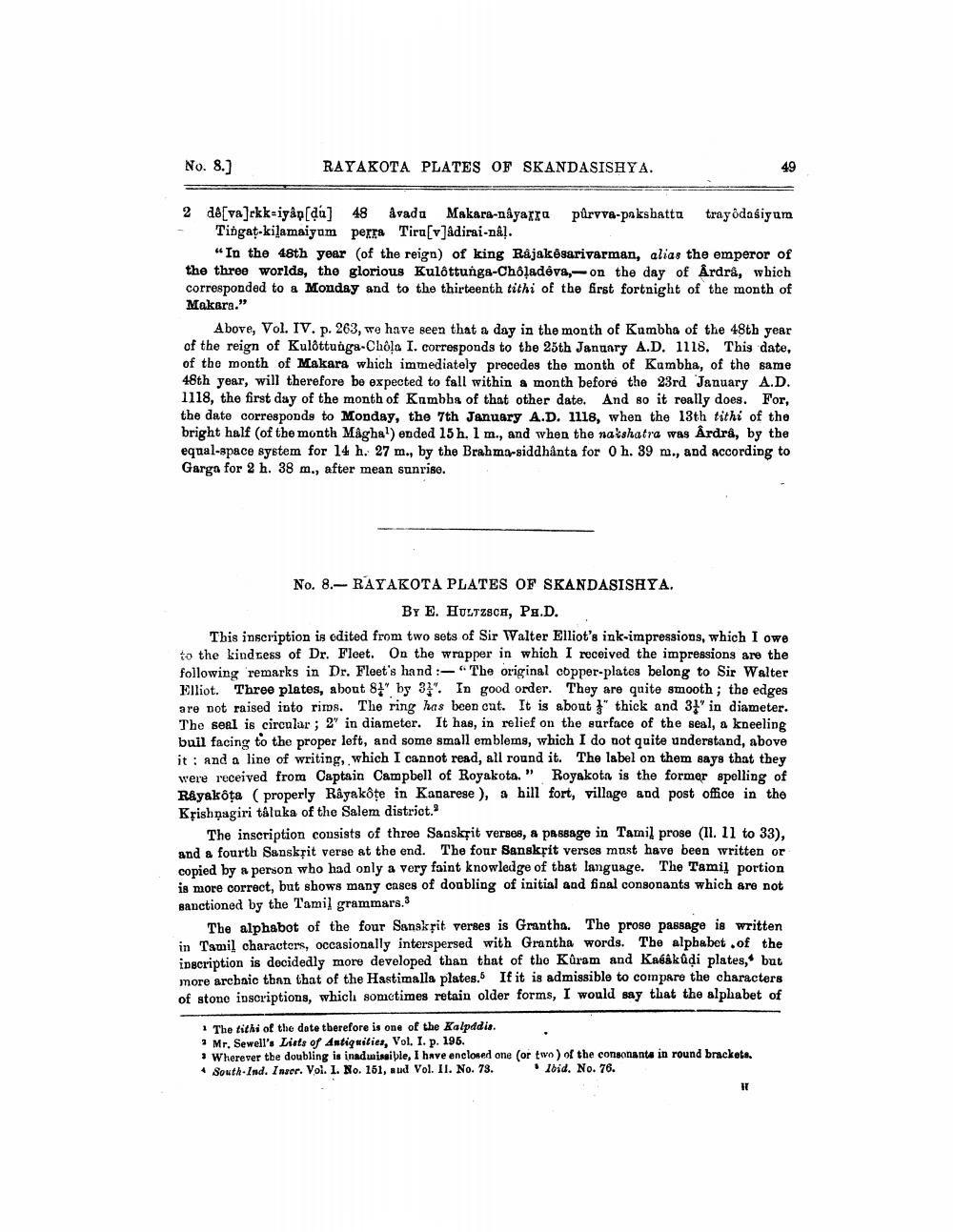________________
No. 8.]
RAYAKOTA PLATES OF SKANDASISHYA.
49
2 d[va]rkk-iyap[au] 48 Avada Makara-nâyarta púryva-paksbatta trayodasiyum - Tingat-kilamaiyam perra Tiru[v]adirai-nål.
“In the 48th year of the reign) of king Råjakesarivarman, alias the emperor of the three worlds, the glorious Kulôttunga-Choladhva-on the day of Årdrå, which corresponded to a Monday and to the thirteenth tithi of the Grst fortnight of the month of Makara."
Above, Vol. IV. p. 263, we have seen that a day in the month of Kumbha of the 48th year of the reign of Kulôttunga-Chola I. corresponds to the 25th January A.D. 1118. This date, of the month of Makara which immediately precedes the month of Kambha, of the same 48th year, will therefore be expected to fall within a month before the 23rd January A.D. 1118, the first day of the month of Kambba of that other date. And so it really does. For, the date corresponds to Monday, the 7th January A.D. 1118, when the 13th tithi of the bright half of the month Maghal) ended 15 h. 1 m., and when the natshatra was Årdrå, by the equal-space system for 14 h. 27 m., by the Brahma-siddhanta for 0 h. 39 n., and according to Garga for 2 h. 38 m., after mean sunrise.
No. 8.-RAYAKOTA PLATES OF SKANDASISHYA.
BY E. HULTZSCH, PA.D. This inscription is odited from two sets of Sir Walter Elliot's ink-impressions, which I owe to the kindless of Dr. Fleet. On the wrapper in which I received the impressions are the following remarks in Dr. Fleet's hand :- " The original copper-platos belong to Sir Walter Elliot. Three plates, about 83" by 31". In good order. They are quite smooth; the edges are not raised into rims. The ring has been cat. It is about }" thick and 31' in diameter. The seal is circular; 2" in diameter. It has, in relief on the surface of the seal, a kneeling buil facing to the proper left, and some small emblems, which I do not quite understand, above it : and a line of writing, which I cannot read, all round it. The label on them says that they were received from Captain Campbell of Royakota.” Royakota is the former spelling of R&yakota (properly Rayakote in Kanarese), a hill fort, village and post office in the Krishnagiri tâluka of the Salem district.
The inscription consists of three Sanskřit verses, a passage in Tamil prose (11. 11 to 33), and a fourth Sanskțit verse at the end. The four Sansksit verses must have been written or copied by a person who had only a very faint knowledge of that language. The Tamil portion is more correct, but shows many cases of doubling of initial and final consonants which are not sanctioned by the Tamil grammars.
The alphabot of the four Sanskrit verses is Grantha. The prose passage is written in Tamil characters, occasionally interspersed with Grantha words. The alphabet .of the inscription is decidedly more developed than that of the Kuram and Kasakudi plates, but more archaic than that of the Hastimalla plates. If it is admissible to compare the characters of stone inscriptions, which sometimes retain older forms, I would say that the alphabet of
The tithi of the date tberefore is one of the Kalpddis. * Mr. Sewell's Lists of Antiquities, Vol. I. p. 195. : Wherever the doubling is inadmissible, I have enclosed one (or two) of the consonants in round brackets. + South Ind. Inser. Vol. I. No. 151, aud Vol. II, No. 73.
Ibid. No. 76.




